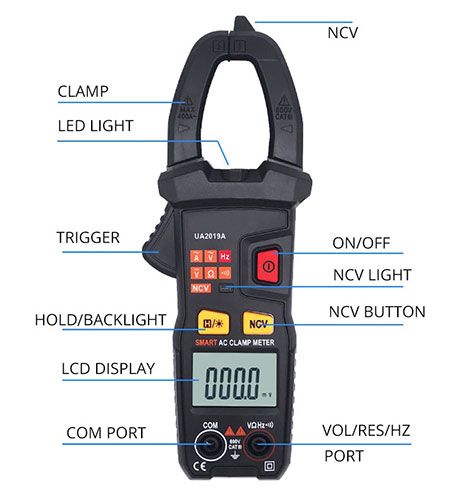What is a Clamp Meter?
The clamp meter is a combination of a current transformer and an ammeter. Usually, when measuring current with an ordinary ammeter, it is necessary to cut off the circuit to stop before the ammeter can be accessed for measurement, which is very troublesome, and sometimes the normal operation of the motor does not allow this to be done. At this time, the use of a clamp ammeter is much more convenient, you can not cut off the circuit to measure the current. ATO online shop will introduce you to the basic components, working principle and main features of a clamp meter.
Clamp meter is a type of ammeter used to measure the value of current in a circuit, or current clamp for short. In electrical and electronic engineering, A current clamp (or current probe) is a device that has two openable clamp-on probes for clamping electrical conductors around electrical equipment, and the probes do not need to be in contact with the conductive portion of the device, i.e., there is no need to disconnect the device wires for the probes to be inserted to measure the properties of the current in the conductor.
Structural Components
- Collet: The collet is the most important part of a clamp ammeter. It is usually composed of a magnetic or iron core with an open C-shaped structure so that clamp meter can be easily clamped around the current conductor to be measured to form a flux loop. One side of the chuck usually has one or more sensors embedded in it to sense changes in the magnetic field caused by the current.

- Control Panel: A clamp meter usually has a control panel located on top of the instrument that includes a digital display and knobs or buttons for selecting measurement ranges and setting functions. The digital display is used to show the value of the current measurement and provide visualization of the data.
- Measurement Circuits: Measurement circuits are responsible for processing the electrical signals received from the collet sensor, converting them into readable digital data, and making the necessary calibrations and adjustments. These circuits typically include amplifiers, analog-to-digital converters (ADCs), and microprocessors.
- Battery or Power Supply: Some clamp ammeters use an internal battery, while other models require power from an external source. The power supply provides the energy to run the various parts of the instrument, including the sensors in the clamp head and the digital display.
- Data Interfaces: Some advanced clamp meters have data logging and communication capabilities that allow them to connect to a computer or other device via USB, Bluetooth, or other interfaces for storing, analyzing, and sharing data.
- Collet Release Button: For safe operation, clamp ammeters are often equipped with a collet release button to open the collet and release the wire under test.
Principle of Operation
The measured circuit wire passing through the core becomes the primary coil of the current transformer, in which the current passing through it induces a current in the secondary coil. Thus, the secondary coil connected to the ammeter will have the indication to measure the current of the line under test. The clamp meter can be through the switch gear, and change different ranges. But the dialing is not allowed to operate with electricity. Clamp meter general accuracy is not high, usually 2.5 ~ 5 level. For ease of use, the meter also has different ranges of changeover switches for measuring different levels of current as well as the function of measuring voltage.
Clamp ammeter is now a very common measuring instrument, technology is more and more mature, and the accuracy is also more and more high, from pure AC to the current AC and DC dual-purpose, from the analog development to the digital type. ATO store provides high quality digital clamp meter AC current 400a, and mini clamp meter AC/DC current 600a, such as the different types of clamp ammeters to choose from. Its basic principle is equivalent to a current transformer, and through the jaws of the measured wire is equivalent to the primary side of the transformer, when the primary side of the current is, the secondary side of the voltage will be induced to produce a current, and then coupled with a variety of circuitry to measure the current on the composition of the clamp-on ammeter. The biggest advantage of a clamp-on current is a hand-held instrument, has no wiring, has online testing, is easy to measure, widely used in electric power, energy, transportation, elevators, and other industries.
Main Features
- Non-contact Measurement: The biggest advantage is that clamp anmeter do not need to cut off the circuit or touch the wires, so the safety is high and will not interfere with the normal operation of the circuit.
- High Accuracy: Modern clamp ammeters typically offer very high measurement accuracy for a wide range of current ranges.
- Versatility: In addition to measuring current, many clamp-on ammeters can measure voltage, resistance, capacity, temperature, and more, making them all-in-one test tools.
- Portability: The clamp meter often have a portable design that makes them easy to carry and operate for fieldwork.
- Data Logging and Communication: Some advanced models have data logging and communication features that allow measurement data to be transferred to a computer or other device for further analysis.
Application Areas
- Power Industry: The clamp anmeter for monitoring current load, wire fault detection, current sensor calibration, etc.
- Electronic Repair: The clamp meter to help technicians detect faulty circuits, and measure the current and voltage of electronic devices.
- Energy Management: Clamp anmeter for tracking energy usage to save energy costs and improve efficiency.
- Construction and Engineering: The good quality clamp meter for wire installation and electrical equipment commissioning to ensure current load balancing.
- Environmental Monitoring: In the field of environmental protection, the clamp meter can be used to monitor the current of electric vehicle charging stations, the current output of solar panels, and so on.

Clamp ammeters are indispensable tools for modern electronic testing and measurement, and their portability, high accuracy, and non-contact nature make them widely used in a variety of current measurement applications. Whether you are an electrical engineer, an electronics technician, or an energy management professional, you will find clamp meters very helpful in improving efficiency and ensuring electrical safety.

